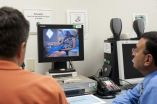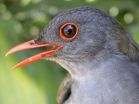(Press-News.org) Scientists have discovered a biological marker that may help to identify which depressed patients will respond to an experimental, rapid-acting antidepressant. The brain signal, detectable by noninvasive imaging, also holds clues to the agent's underlying mechanism, which are vital for drug development, say National Institutes of Health researchers.
The signal is among the latest of several such markers, including factors detectable in blood, genetic markers, and a sleep-specific brain wave, recently uncovered by the NIH team and grantee collaborators. They illuminate the workings of the agent, called ketamine, and may hold promise for more personalized treatment.
"These clues help focus the search for the molecular targets of a future generation of medications that will lift depression within hours instead of weeks," explained Carlos Zarate, M.D., of the NIH's National Institute of Mental Health (NIMH). "The more precisely we understand how this mechanism works, the more narrowly treatment can be targeted to achieve rapid antidepressant effects and avoid undesirable side effects."
Zarate, Brian Cornwell, Ph.D., and NIMH colleagues report on their brain imaging study online in the journal Biological Psychiatry.
Previous research had shown that ketamine can lift symptoms of depression within hours in many patients. But side effects hamper its use as a first-line medication. So researchers are studying its mechanism of action in hopes of developing a safer agent that works similarly.
Ketamine works through a different brain chemical system than conventional antidepressants. It initially blocks a protein on brain neurons, called the NMDA receptor, to which the chemical messenger glutamate binds. However, it is not known if the drug's rapid antidepressant effects are a direct result of this blockage or of downstream effects triggered by the blockage, as suggested by animal studies.
To tease apart ketamine's workings, the NIMH team imaged depressed patients' brain electrical activity with magnetoencephalography (MEG). They monitored spontaneous activity while subjects were at rest, and activity evoked by gentle stimulation of a finger, before and 6.5 hours after an infusion of ketamine.
It was known that by blocking NMDA receptors, ketamine causes an increase in spontaneous electrical signals, or waves, in a particular frequency range in the brain's cortex, or outer mantle. Hours after ketamine administration—in the timeframe in which ketamine relieves depression – spontaneous electrical activity in people at rest was the same whether or not the drug lifted their depression.
Electrical activity evoked by stimulating a finger, however, was different in the two groups. MEG imaging made it possible to monitor excitability of the somatosensory cortex, the part of the cortex that registers sensory stimulation. Those who responded to ketamine showed an increased response to the finger stimulation, a greater excitability of the neurons in this part of the cortex.
Such a change in excitability is likely to result, not from the immediate effects of blocking the receptor, but from other processes downstream, in the cascade of effects set in motion by NMDA blockade, say the researchers. Evidence points to changes in another type of glutamate receptor, the AMPA receptor, raising questions about whether the blocking of NMDA receptors is even necessary for ketamine's antidepressant effect. If NMDA blockade is just a trigger, then targeting AMPA receptors may prove a more direct way to effect a lifting of depression.
A separate study of ketamine biomarkers by the NIMH group adds to evidence that the drug may work, in part, by strengthening neural connections. Thirty treatment resistant depressed patients who received ketamine showed increased sleep-specific slow brainwave activity (SWA) – a marker of such strengthened synapses and of increased synchronization of networks in the cortex. They also had higher blood levels of a key neural growth chemical, brain-derived neurotrophic factor (BDNF), previously linked, in animal studies, to ketamine's action. Intriguingly, the boosts in BDNF were proportional to those in SWA only among 13 participants whose depressions significantly lifted – suggesting a potential marker of successful treatment.
"Linked SWA and BDNF may represent correlates of mood improvement following ketamine treatment," said Zarate. "These may be part of the mechanism underlying the rapid antidepressant effects and prove useful in testing potential new therapies that target the glutamate system."
The increases in SWA, detected via electroencephalography (EEG), were also reflected in increased slope and amplitude of individual brainwaves – additional indicators of neural health and adaptability.
Prior to discovery of ketamine's antidepressant effects, the only fast-acting antidepressant therapies were sleep deprivation and electroconvulsive therapy (ECT), both of which are also thought to work, at least in part, by stimulating BDNF.
There is also new evidence that people with one of two common versions of the gene that codes for BDNF respond better to ketamine – and clues about why. The versions are created by a site in the human BDNF gene where the genetic code differs slightly across individuals. Each person inherits two copies of the gene, one from each parent. So people can inherit one or two copies of each version.
In June, NIMH-funded researchers reported that ketamine's ability to spur the growth of neural connections and trigger antidepressant-like behavioral responses was impaired in mice genetically engineered to express two copies of a risk version of the human BDNF gene that is carried by about 30 percent of the population. NIMH grantees George Aghajanian M.D., and Ronald Duman, Ph.D., of Yale University, New Haven, Conn., also discovered atrophy in extensions of neurons and dampened electrical activity in key cells at the front of the brain, with the risk version.
The mouse results suggested that the same site of variability in the BDNF gene might similarly influence patients' responses to ketamine. In July, Zarate and NIMH colleagues reported that in 62 depressed patients, this variability in the BDNF gene accounted for 28 percent of difference in patients' responsiveness to the medication. As expected, the antidepressant effect was strongest in patients with two copies of the other, protective version, which is carried by about 60 percent of the population.
These results strengthen the case for BDNF's pivotal role in mediating antidepressant effects produced via the glutamate system. They also suggest that it might be possible to improve ketamine's antidepressant effect in risk version carriers by first giving them treatments known to enhance BDNF, such as exercise, transcranial magnetic stimulation, ECT, or conventional antidepressants.
In another recent study by the NIMH team and NIH collaborators, by-products of the chemical breakdown of ketamine, detectable in blood, helped to sort out responders from non-responders, as well as diagnosis and symptoms. This first study of its kind pinpointed correlates of such downstream ketamine metabolites in 45 treatment resistant depressed unipolar and 22 depressed bipolar patients.
Blood levels of one metabolite were higher among bipolar non-responders, indicating that these patients might require a lower dose of the drug for optimal efficacy. Levels of three related metabolites were higher in bipolar patients, with only one, of a different type, elevated in patients with major depression. Higher levels of three metabolites of the former type were also associated with lower scores on measures of psychotic and other side effects, following ketamine treatment. The identification of these downstream metabolites opens the door to possibly developing them into newer treatments that are better tolerated than ketamine.
Ketamine also recently produced the fastest, strongest and longest-lasting anti-suicidal intervention ever demonstrated in a controlled trial, according to Zarate and colleagues. In a replication of an earlier study, the researchers confirmed that ketamine not only lifts depression, but also reduces suicidal thoughts in bipolar patients. The effects were detectable as soon as 40 minutes after a single infusion in 15 treatment resistant patients taking mood stabilizers, and remained significant for at least a few days. Three fourths of the patients responded to ketamine, with none responding to a placebo. The results add reduced suicidal thinking to the list of potential therapeutic benefits of targeting the brain's glutamate system.
While the research on biological markers and mechanisms holds hope for development of more practical medications in the long term, questions remain about whether there might be a limited role for ketamine itself in the short term.
In a recent assessment of the state of the science, Zarate and American and European colleagues propose that intravenous ketamine may prove useful for acutely suicidal patients who receive treatment in hospital emergency rooms. It may also offer an alternative to ECT, long considered the treatment of last resort for treatment resistant depression, but fraught with concerns about cognitive side effects.
However, the researchers recommend against the use of ketamine outside of a hospital setting, citing potential cardiovascular and other risks. They note that anesthesiologists participate in the trials at NIMH and Mount Sinai School of Medicine, New York City which also require a 24-hour inpatient stay following drug infusion.
Among about 163 patients who have been studied to date, the drug has been well tolerated and seems a reasonable treatment option for most treatment resistant depressed patients, say the researchers. Studies are under way using nasally administered ketamine and other strategies to determine how the rapid antidepressant affect might best be sustained.
"We are investigating ketamine in multiple ways – studying genes, gene expression, synapses, cells, circuits, and symptoms with neuroimaging, genetics, electrophysiological measures and other techniques," explained Zarate. "These studies hold hope for predicting the likelihood of response and for gaining insights into mechanisms of action."
INFORMATION:
References
Synaptic Potentiation Is Critical for Rapid Antidepressant Response to Ketamine in Treatment-Resistant Major Depression. Cornwell BR, Salvadore G, Furey M, Marquardt CA, Brutsche NE, Grillon C, Zarate CA Jr. Biol Psychiatry. 2012 Apr 20. [Epub ahead of print] PMID: 22521148
Concomitant BDNF and sleep slow wave changes indicate ketamine-induced plasticity in major depressive disorder. Duncan WC, Sarasso S, Ferrarelli F, Selter J, Riedner BA, Hejazi NS, Yuan P, Brutsche N, Manji HK, Tononi G, Zarate CA. Int J Neuropsychopharmacol. 2012 Jun 7:1-11. [Epub ahead of print] PMID: 22676966
Relationship of Ketamine's Plasma Metabolites with Response, Diagnosis, and Side Effects in Major Depression. Zarate CA Jr, Brutsche N, Laje G, Luckenbaugh DA, Venkata SL, Ramamoorthy A, Moaddel R, Wainer IW. Biol Psychiatry. 2012 Apr 18. [Epub ahead of print]
PMID: 22516044
Replication of ketamine's antidepressant efficacy in bipolar depression: a randomized controlled add-on trial.Zarate CA Jr, Brutsche NE, Ibrahim L, Franco-Chaves J, Diazgranados N, Cravchik A, Selter J, Marquardt CA, Liberty V, Luckenbaugh DA. Biol Psychiatry. 2012 Jun 1;71(11):939-46. Epub 2012 Jan 31.PMID: 22297150
Ketamine for Depression: Where Do We Go from Here? Aan Het Rot M, Zarate CA Jr, Charney DS, Mathew SJ. Biol Psychiatry. 2012 Jun 15. [Epub ahead of print] PMID: 22705040
Brain-Derived Neurotrophic Factor Val66Met Polymorphism and Antidepressant Efficacy of Ketamine in Depressed Patients. Laje G, Lally N, Mathews D, Brutsche N, Chemerinski A, Akula N, Kelmendi B, Simen A, McMahon FJ, Sanacora G, Zarate C Jr. Biol Psychiatry. 2012 Jul 5. [Epub ahead of print] No abstract available. PMID:22771240
Brain signal IDs responders to fast-acting antidepressant
Biomarkers help pinpoint mechanisms, predict outcomes -- NIH studies
2012-08-07
ELSE PRESS RELEASES FROM THIS DATE:
Scientists define new limits of microbial life in undersea volcanoes
2012-08-07
By some estimates, a third of Earth's organisms live in our planet's rocks and sediments, yet their lives are almost a complete mystery.
This week, the work of microbiologist James Holden of the University of Massachusetts-Amherst and colleagues shines a light into this dark world.
In the journal Proceedings of the National Academy of Sciences (PNAS), they report the first detailed data on methane-exhaling microbes that live deep in the cracks of hot undersea volcanoes.
"Evidence has built that there's an incredible amount of biomass in the Earth's subsurface, in ...
WSU researcher sees how forests thrive after fires and volcanoes
2012-08-07
PULLMAN, Wash.—Forests hammered by windstorms, avalanches and wildfires may appear blighted, but a Washington State University researcher says such disturbances can be key to maximizing an area's biological diversity.
In fact, says Mark Swanson, land managers can alter their practices to enhance such diversity, creating areas with a wide variety of species, including rare and endangered plants and animals.
"The 1980 eruption of Mt. St. Helens, for example, has created very diverse post-eruption conditions, and has some of the highest plant and animal diversity in the ...
Birds do better in 'agroforests' than on farms
2012-08-07
SALT LAKE CITY, Aug. 7, 2012 – Compared with open farmland, wooded "shade" plantations that produce coffee and chocolate promote greater bird diversity, although a new University of Utah study says forests remain the best habitat for tropical birds.
The findings suggest that as open farmland replaces forests and "agroforests" – where crops are grown under trees – reduced number of bird species and shifts in the populations of various types of birds may hurt "ecosystem services" that birds provide to people, such as eating insect pests, spreading seeds and pollinating ...
Color-coded labels improve healthy food choices in employees from all backgrounds
2012-08-07
A program designed to encourage more healthful food choices through simple color-coded labels and the positioning of items in display cases was equally successful across all categories of employees at a large hospital cafeteria. In an article appearing in American Journal of Preventive Medicine, a team of Massachusetts General Hospital (MGH) researchers report that the interventions worked equally well across all racial and ethnic groups and educational levels.
"These findings are important because obesity is much more common among Americans who are black or Latino ...
Few kids use recommended safety restraints in cars
2012-08-07
San Diego, CA, August 7, 2012 – Despite the fact that car crashes are the leading cause of death for children older than three years in the U.S. and send more than 140,000 children to the emergency room each year, new research has found that low proportions of U.S. children are using age-appropriate safety restraints and many are placed at risk by riding in the front seat. The research is published in the September issue of the American Journal of Preventive Medicine.
The American Academy of Pediatrics issued new Guidelines for Child Passenger Safety in 2011. They ...
Sompo Japan China Selected as 2011 Goldenbee CSR China Honor Roll Company
2012-08-07
Sompo Japan Insurance (China) Co.,Ltd (hereafter gSompo Japan Chinah Vice Chairman, President :Katsuhiko Ushiba) has been selected for the second consecutive year as one of the 2011 GoldenBee CSR China Honor Roll companies (hereafter gGoldenBee companiesh) at the 7th International CSR forum & ceremony (hosted by China WTO Tribune and the Sino-German CSR Project) held in Beijing on June 5th, 2012.
1. About the GoldenBee CSR China Honor Roll
The GoldenBee CSR China Honor Roll is a corporate social responsibility (CSR) evaluation program organized annually by ...
8/7/12 Wellness, Wholeness & Wisdom Radio Host, Psychologist Parthenia Izzard, CNHP will talk again LIVE with Gerry Gavin, Author of, Messages from Margaret: For the Year 2012 and Beyond
2012-08-07
Every Tuesday, Wednesday, and Thursday evening at 8:00 PM eastern time, you can listen to Wellness, Wholeness & Wisdom radio with host Psychologist & Certified Natural Healthcare Practitioner Parthenia Izzard, CNHP on BlogTalkRadio. The program is archived within minutes of the live broadcast on the internet and rebroadcast. On your computer go to http://www.amtherapies.com and click on the Radio link to listen to the show live online or on your phone! Program topics range from authors like Bishop Jordan, James Redfield, Immaculee Ilibagiza, and William Tiller to ...
New Wave Of Electronic Music - Chill EP By Plastic Shaman & Soulsa
2012-08-07
Electronic producer Plastic Shaman & vocalist Soulsa from Bristol, UK have built up a solid reputation through the year and have finally decided it was time to release an EP that their fans had been so desperately waiting for.
The EP brings together a completely diverse a wide range of creative sound from throughout the whole electronic music world. The official video for the main track "Chill" from the EP is out now. It comes a long way from Plastic Shaman's Previous EP "Hallucinogenic Bear" which featured Soulsa on the very successful track ...
EF Education First and Moscow State University Announce Research Collaboration
2012-08-07
EF Education First (EF) and Moscow State University (MSU) announced today plans to establish research collaboration in the field of English language learning, teaching, and assessment. A Memorandum of Understanding was signed by Dr. Christopher McCormick, EF's Senior Vice-President for Academic Affairs, and Dr. Svetlana Ter-Minasova, President of the Faculty of Foreign Languages and Area Studies, at Lomonosov Moscow State University (MSU FFLAS).
The collaboration between EF and MSU FFLAS will focus on language-related research such as adult and younger learners' second ...
Silverland Jewelry & Gifts Offers Beautiful Bridal Jewelry
2012-08-07
Silverland Jewelry & Gifts is inviting the public to check the newest bridal collections that they have. The company is proud to present the different jewelry collections that they have for brides as well as their bridesmaids. Their website currently shows all of their available collections to make it easier for brides-to-be to choose the best jewelry. The company also sells different types of wedding favors and thank-you gifts to groomsmen, bridesmaids, and a lot more. Those who are interested in checking their merchandise can do so by checking their physical and online ...
LAST 30 PRESS RELEASES:
GIMM uncovers flaws in lab-grown heart cells and paves the way for improved treatments
Cracking the evolutionary code of sleep
Medications could help the aging brain cope with surgery, memory impairment
Back pain linked to worse sleep years later in men over 65, according to study
CDC urges ‘shared decision-making’ on some childhood vaccines; many unclear about what that means
New research finds that an ‘equal treatment’ approach to economic opportunity advertising can backfire
Researchers create shape-shifting, self-navigating microparticles
Science army mobilizes to map US soil microbiome
Researchers develop new tools to turn grain crops into biosensors
Do supervised consumption sites bring increased crime? Study suggests that’s a myth
New mass spec innovation could transform research
Maternal nativity, race, and ethnicity and infant mortality in the US
Migration-related trauma among asylum seekers exposed to the migrant protection protocols
Jupiter’s moon Europa has a seafloor that may be quiet and lifeless
SwRI upgrades nuclear magnetic resonance laboratory for pharmaceutical R&D
House sparrows in northern Norway can help us save other endangered animals
Crohn's & Colitis Foundation survey reveals more than 1/3 of young adults with IBD face step therapy insurance barriers
Tethered UAV autonomous knotting on environmental structures for transport
Decentralized social media platforms unlock authentic consumer feedback
American Pediatric Society announces Vanderbilt University School of Medicine as host institution for APS Howland Visiting Professor Program
Scientists discover first method to safely back up quantum information
A role for orange pigments in birds and human redheads
Pathways to net-zero greenhouse gas emissions for Southeast Asia
A JBNU–KIMS collaborative study on a cost-effective alloy matches superalloys for power plants and energy infrastructure
New study overturns long-held model of how plants coordinate immune responses.
New AI model predicts disease risk while you sleep
Scientists discover molecular ‘reshuffle’ and crack an 80-year-old conundrum
How stressors during pregnancy impact the developing fetal brain
Electrons lag behind the nucleus
From fungi to brain cells: one scientist's winding path reveals how epigenomics shapes neural destiny
[Press-News.org] Brain signal IDs responders to fast-acting antidepressantBiomarkers help pinpoint mechanisms, predict outcomes -- NIH studies



